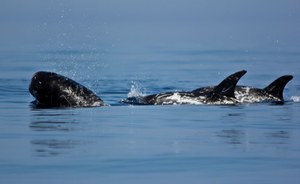Refining tools for cetacean conservation
Species Distribution Modeling (SDM) is a powerful tool employed by researchers to pinpoint critical areas essential for species survival. This tool holds particular significance when studying and conserving species like cetaceans, whose large-scale movements in the vaste marine environment pose challenges for continuous monitoring across its entire extention.
As part of the Life CONCEPTU MARIS project, ISPRA led a comprehensive evaluation of the most commonly used SDM tools to delineate favorable habitats for three rare cetacean species: the Risso's dolphin, the long-finned pilot whale, and the Cuvier's beaked whale.
The findings underscore key areas of importance for these species within the Mediterranean region. The study revealed the critical significance of the Western Mediterranean while highlighting the urgent need to address data scarcity in much of the central and eastern portions of the basin.
The standardization of the investigative SDM tool will enable the monitoring of eventual shifts in species distribution and habitat use over time. This, in turn, will facilitates the early adaptation of conservation strategies or mitigation measures.
The full article is available in Aquatic Conservation, Marine and Freshwater Ecosystems:
Arcangeli A., Azzolin M., Babey L., David L., Garcia-Garin O., Moulin A., Rosso M., Scuderi A., Tepsich P., Vighi and Orasi A. (2024) Looking for reliable Species Distribution Models for low-density cetacean species: compared effectiveness of SDMs for G.griseus, G.melas, Z.cavirostris in the Mediterranean Sea based on long-term fixed-transect data. Aquatic Conservation: Marine and Freshwater Ecosystems. http://doi.org/10.1002/aqc.4115
The article can also be request to: antonella.arcangeli@isprambiente.it, arianna.orasi@isprambiente.it
More information:
The EU regulative framework for the protection of marine biodiversity and habitats requires the assessment of species' conservation status and the identification of core habitats to design adequate conservation and management plans. However, the identification of distribution range and habitat-use of pelagic large-range, migratory species, such as cetaceans, is challenging.
Species distribution models (SDMs) are increasingly used in conservation planning to identify species priority areas. However, the quality of SDMs varies widely depending on the representativeness of data and the appropriateness of the modelling techniques.
Since 2007, the Fixed Line Transect Mediterranean Monitoring Network (FLT Med Net) has been continuously monitoring cetaceans throughout the year in the Mediterranean basin using passenger ferries as observation platforms that perform repetitive surveys along fixed trans-border transects. 4. With the aim of defining a standard analytical approach, the data collected by the FLT Med Net on rarer Mediterranean cetacean species (i.e., Grampus griseus, Globicephala melas, Ziphius cavirostris) are used here to assess the performance of commonly used SDMs, including GLM, GAM, GAM-Negative Binomial, GAM tweedy, MaxEnt and Random Forest. Models were built and evaluated using a total of 296 FLT Med Net sighting data and cross-validated using 145 independent data points.
Under testing conditions, almost all methods exhibited good performance, with Random Forest being the best model in several cases. However, when evaluated with the independent dataset, many models yielded inconsistent results or notably low performance. Only MaxEnt demonstrated consistent efficiency and reliability in both cases, showing results less affected by unequal sampling or small sample size.

Credits: Maps Arcangeli et al., 2024 (http://doi.org/10.1002/aqc.4115); species drawings E.Mitrovic.

